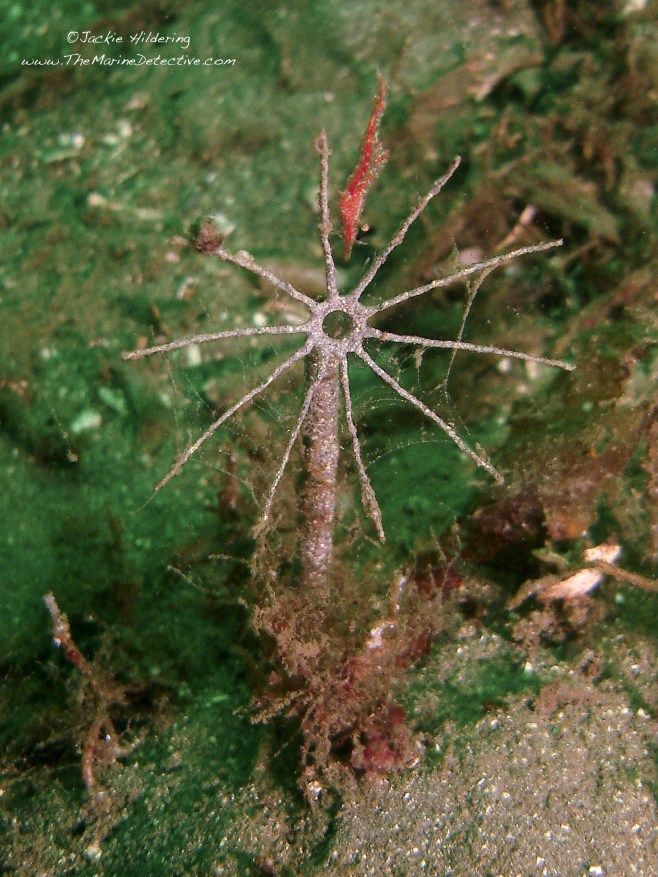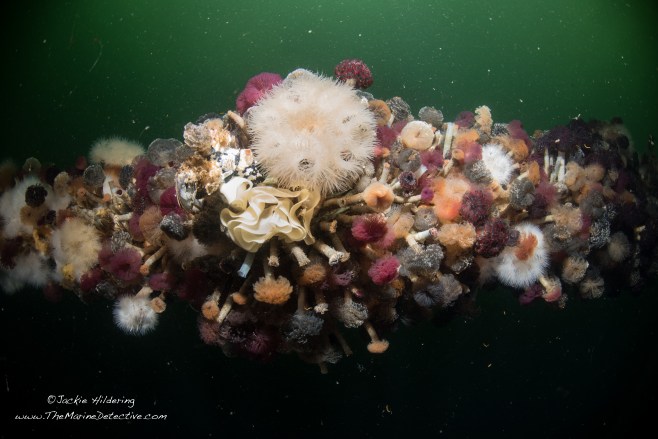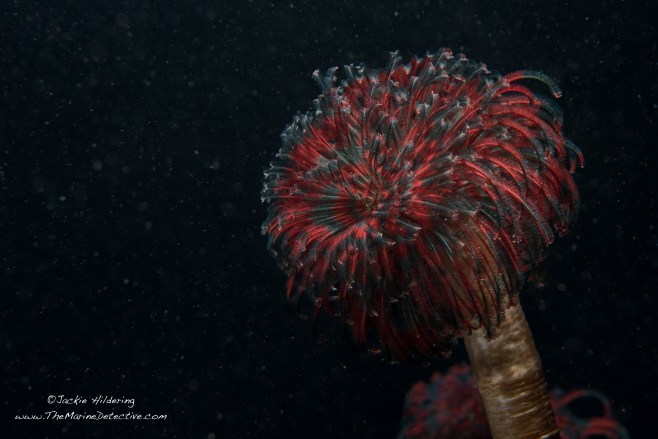Mystery Worm
The species of necklace-worm in the following two photos has, to my knowledge, not yet been identified by science. My latest sighting of it was yesterday.
I am sharing the images to illuminate anew how little we know even of species in the shallows.
I have only documented this species 3 times and in each case it has been in less than 8 metres / 25 feet of water. Interestingly, it was near Proliferating Anemones in each case which makes me wonder if the might prey on them. I am perplexed too by the slime encasements evident in the second photo.
I believe it has also only been documented around the Plumper Islands area off NE Vancouver Island.
I have relayed the observations to polychaete worm experts.


To be clear, I did not discover the species.
I have only found individuals of this necklace-worm that has previously been recognized by experts as being an unidentified species.
In Andy Lamb and Bernie Hanby’s “Marine Life of the Pacific Northwest”, it is species AN22. They state: “While diving the Plumper Islands near Port McNeill, BC, we found this mystery necklace-worm. Significant numbers of this small (5 cm / 2 in long) creature were crawling about in the open, completely exposed. Such behaviour would seem to invite predation. Unfortunately, without a specimen . . . accurate identification is not possible. Detailed examination of the palps, teeth, cirri (finger-like projections) and chaetae (bristles) are required for species determination . . . It looks diminutive, but this mysterious worm is actually large compared to most necklace-worms.” Further from their update on KnowBC; “Some interesting observations can be made, however. The tentacular cirri near the head are much longer than their dorsal counterparts in the middle of the body: the latter appear to be shorter than the worm’s body width. It is not clear, though, whether these cirri are annulated (ringed) or smooth. The specimen’s eyes are evident as are some sensory organs located just behind them. Intriguing features are the two faint but obvious transverse structures on each segment that appear to be ciliated (hairy).”
Oh and because truth, humility and self-mockery are virtues I try to stand for, know that I had no idea I had photographed the species yesterday. I only saw it when I was processing my photos of the Proliferating Anemones. There are good reasons I dive with a magnifying glass.

Below, please find photos of just a few of the other species of marine worm that I have photographed around NE Vancouver Island.
I am sharing these to add to the wonder of worms found in the NE Pacific Ocean.
#1 Windmill Bamboo Worm
Praxillura maculata to 25 cm long.
This species makes 6 to 12 “vanes”/spokes at the end of its protective tube and then strings a web-like net of mucus between to capture bits of food. After a time, the worm comes OUT of its tube and eats the mucus and food! Yep, it seines for its dinner! See this link for photos by Ronald Schmek of the worm coming out of its tube to harvest dinner.

#2 Basket-Top Spaghetti-Worm
Pista elongata to 21 cm long
The Basket-Top Spaghetti-Worm builds a tube AND A BASKET from bits of debris and extends its tentacles through the basket to feed. So little is known about it.
From Lamb and Hanby: “The lower part of the tube, where the worm resides, is coated with shell fragments and pebbles. Is the purpose of this extravagant tube solely to camouflage and protect the worm . . . or to increase its access to food? The worm extends its long tentacles through the basket to gather food particles selectively . . . The basket-top may also function as a sieve, filtering out particles brought by currents. Elevating the tube above the rocky substrate may provide the elongate, and tree-like branchia (gills), hidden in the basket, with a good supply of oxygenated water.”


#3 Calcarious Tubeworms
There are a variety of Calcareous Tubeworms species in the NE Pacific Ocean. I believe those in the following photos are “Red-Trumpet Calcareous Tubeworms” (Serpula coumbiana to 6.5 cm long). You’ve probably deduced that with that large surface area, they dust for plankton snacks with their crowns. These structures also allow the animals to respire.
See the trumpet-like structures (which need not be red as the common name suggests)? That is the “operculum”. It functions like a door that pulls closed after the tubeworm retracts. Thereby the worm is further protected in its hard, shell-like tube of a home
I am always thrilled when I succeed in photographing this species since, with any disturbance, the crown Immediately retracts as of result of they eye spots detecting the change in light / shadow.



#4 Jointed Three-Section Tubeworm
Spiochaetopterus costarum to 48 cm long
Jointed Three-Section Tubworms are filter feeders that create mucus bags inside their bodies through which water is passed due to the beating of cilia. As the water passes through the mucus, plankton and detritus particles are sieved out. The long polyps you see in my first photo below, remove the pellets and keep the opening of the worm clear. Notice how thin the worm is and therefore how spacious the tube it has constructed? The second photo shows you what the pellets look like.
The nudibranch species in the first images is an Opalescent Nudibranch which is likely feeding on a species of hydroid on the outside of the worm’s tube.
The nudibranch species in the third and fourth photo is Himatina trophina which not only feeds on hydroids on the outside of the tube but also, as you can see, lays its egg ribbons there.




#5 Slime-Tube Feather Duster Worms
Myxicola infundibulum to 9 cm long
This species can also detect shadow and retreat into their mucus homes with lightning speed. All you then see is the jiggly jello-like top of their tubes. (Yes, it took me a long time to get a photo of them!) Where other marine tube-worms make a parchment or shell-like tube, worms of the Myxicola genus secrete themselves a mucus home. “Myxicola” in fact translates into “living in slime” so don’t name your child that ![]() . They suspension feed on plankton and other bits of organic bits with their funnel-like crowns ( = “radioles”).
. They suspension feed on plankton and other bits of organic bits with their funnel-like crowns ( = “radioles”).

#6 Feather Duster Tube-Worms
It is very easy to see why these are known as “feather duster” worms. Their crowns have huge surface area to “dust” the ocean for food. They live in parchment tubes and feed on plankton with their bushy crowns.
The banded blue and purple ones with the thicker tubes are the Vancouver Feather-Duster (Eudistylia vancouveri to 25 cm long). The pink, grey and tan ones are Split-Branch Feather-Dusters (Schizobranchia insignis to 15.8 cm long).

Vancouver Feather-Duster and Split-Branch Feather-Dusters. See the nudibranch egg mass under the biggest Plumose Anemone? Those are from a Monterey Dorid.

Split-Branch Feather-Dusters (Schizobranchia insignis to 15.8 cm long).

Vancouver Feather-Duster (Eudistylia vancouveri to 25 cm long).
#7 Sea Nymphs / Nereidae Worms
There are more than 20 species of nereida worms in the NE Pacific Ocean and the one that I am asked about most often is the “Giant Pile Worm” (Alitta brandti). It is indeed giant at up to 1.5 long and causes wonder and confusion; even getting misidentified as being an eel instead of a worm.
The video below shows a male spawning at the surface.
4 Responses to “Mystery Worm”
Wow. How amazing.
Fascinating!
Hi Jackie I am very happy to be back online and getting your posts again! You are one of my last connections to that Wonderworld I used to visit (wow – that almost waxed poetic eh). It was hard to say for sure but I think the photo you showed the gelatinous like cage looked the same as the critter I saw for my first time in the skook narrows and which I attached the name sheathed bristle-cage worm, Flabelligera affinis. I had sightings (photos) of it also from whytecliff park North wall and yes, ne pearse. Well done find and next time play with them in their cage by gently tapping them and watch them start to come out escape – fascinating as they deliberate between the danger outside and inside, backing in and then crawling out in the process. I donât know why I was able to get the Latin name unless it was that I had also gone down your road and submitted it to Sheila? for help. Kinda out of the loop now but still interested and so much fun following your posts! Loved to killer female analogy. Good work, motor on my friend. Paul.
Just sent you an email my friend re. relaying your valued observations and photos.